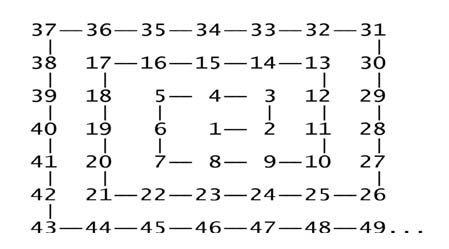The whole thing is now known as the Ulam Spiral, which even today, nobody has yet fully explained.
Often, what strikes humanity into humble submission are the staggering surprises.
Take the circle, for example. Any circle seems so simple; take one look, and it seems clear a circle will be unable to hide anything. It’s just some naked shape. But once you succumb to the seduction of attempting to look at the ratio of a circle’s circumference to its diameter, you’re like opening Pandora’s box: you’re met with the maddening complexity of the pi's endless string of numbers—3.14 off into infinity.
The numbers jump out of the box to bury you under its staggering endlessness.
These mysteries help you understand why mathematicians talk about numbers as if the subject of conversation were the curves of Eva Longoria or Naomi Watts. Mention something like Fermat's last theorem to somebody like Carl Friedrich Gauss, and the guy would probably have a hard-on. Whisper the Poincare conjecture to Grigori Perelman, and he would probably wet his pants and wax nostalgic. Math is so seductive because, for one thing, it’s like everybody’s Lady in Red—she’s this beauty that seems to be both “easy” and hard to get, both so happily understandable and so deeply confounding. And that’s just the stuff undying romances are made of.
But sometimes, math can be a bitch.
That line was on my mind a decade ago when I had the epiphany I loved calling “The Day the Truth Fucked Me.”
The said epiphany basically says: “Goddamit. I am not a math person.”
This was after I had successfully convinced my father to buy me my first personal desktop computer. This was after I had bought all those pricey math textbook references that were supposed to do to me what spinach did to Popeye: Make me tough and “muscled” enough to face and grapple with algebraic confusions.
I was in my third year as an engineering student. I was on my study table, a three-inch-thick physics textbook parted before me, when the epiphany hit me. I could even tell you what went through my head at the exact moment on that day in 1995; I could tell you how the newly-bought book’s pages smelled, and which cassette tape I was playing in the deck (U2’s Zooropa). But none of these small things matters, really. What matters was that I was quitting; that the following day, I would be dropping all my math subjects. What matters was that finally, I was admitting I was a technical loser, after all. That I would never have Bohr's insight, or Newton's precociousness.
But despite admitting defeat, I continued standing outside the fence of the happy party, refusing to just turn my back on it all and walk away; I would avidly consume anything if it had something to do with folks like Stephen Hawking or Richard Feynman or when there’s news about the planned terraforming on Mars. I would pounce on every copy of Discover or Wired, and because those were days I lived on a measly allowance, I would kid my friends that I was devising a scheme on how to steal more copies of these magazines from a nearby bookstore—and usually, nobody would notice I was in fact serious.
My “failure” has been responsible in making me an obsessive bystander, “watching” Sagan or Dawkins do all the work while I root for them halfway around the world, in my room deep in the bowels of the Third World.
But sometimes, I wonder how it might be if I were some math whiz like Maximillian Cohen in Darren Aronofsky’s 1998 film, Pi. The main character is a social outsider who believes everything in nature can be understood through numbers. Max is obsessed with patterns.
[A sample of the Ulam Spiral]
Although widely criticized for its flawed and muddled Kabbalah and Western math, the film is intriguing enough because of the questions it poses. There’s the layer of meaning that says the universe’s fabric, from the very large to the very small, can be plotted with numbers; step back far enough—like what Ulam did with the grid of prime numbers—and you might see a pattern. The name of God, maybe. The future of the stock market. Or just the little cherished answer to your most personal question.
Sure, you can’t take these things at face value. Especially because each question mankind manages to answer only gives birth to another set of questions previously unimagined. But that’s the beauty of it, isn’t it? Because it shows us that there will always be some more “staggering surprises” left lying around in the universe, promising us that we’ll never run out of wonder, telling us that humankind will probably never stop running on the eternal treadmill.
These surprises are just waiting for the next fool, waiting for the next wunderkind to find them.
***
For similar posts, see Random Acts of Strangeness.
Tags:




No comments:
Post a Comment